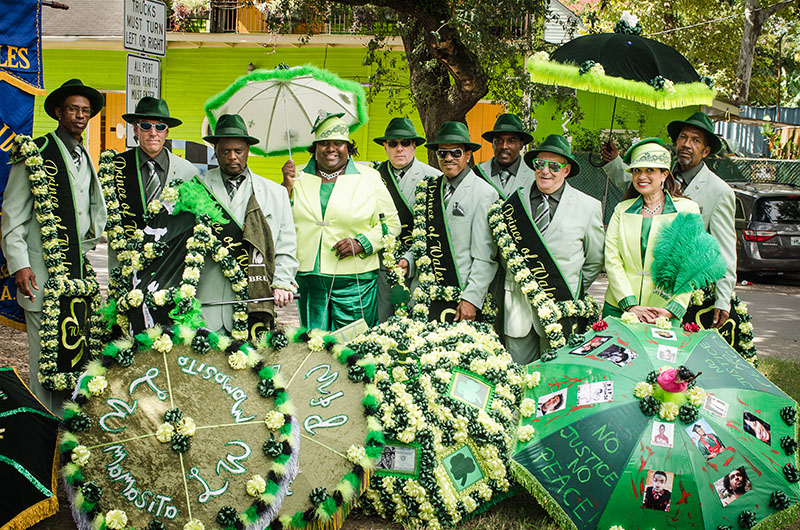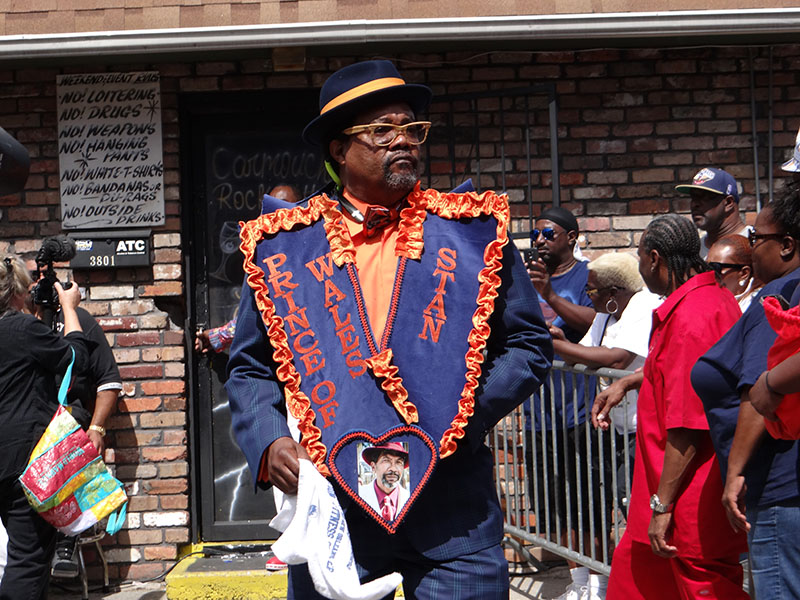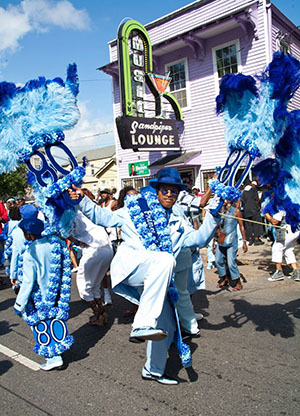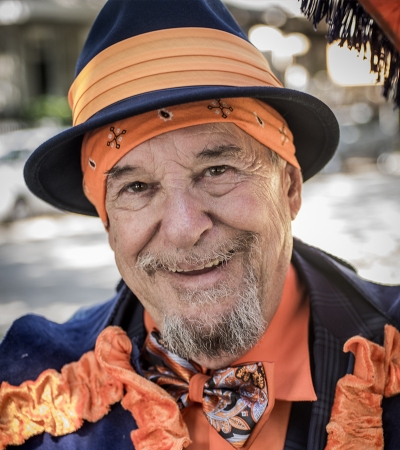A Collective Way
It’s hard to imagine, in a collective way, having more fun than a second line parade. It’s just a nation of joy and exuberance. Prince of Wales is one of the oldest social and pleasure clubs in New Orleans. It formed in 1928, mostly from people in the Twelfth and Thirteenth Wards. Originally, a lot of the people in the club were working on the river as longshoremen. I was told, at one point members also ran barrooms, so the parade route had a lot of stops. Back in those days, parades were way longer than four hours. When you’d stop, you might hang out for a half hour having a drink and eating something before going on to the next barroom. New clubs are popping up all the time, but I don’t think there’s as a much of a relationship to neighborhoods like there used to be because the neighborhoods are disappearing.
I moved to New Orleans from Chicago in January of 1980 to do political work with Malcolm Suber and Leon Waters. We were in the same political organization—the Communist Party U.S.A. It was right at the end of the oil boom, and I was married at the time. I ended up breaking up with my wife and moved to Constance and General Pershing in the Twelfth Ward. The way New Orleans historically developed, there were poor neighborhoods next to rich neighborhoods because rich people needed cooks and babysitters and all that. It wasn’t as divided as other cities I’ve lived in.
The Twelfth Ward was a real neighborhood back then. It really was the “Big Easy.” Rents were 250, 300 dollars. There were all kinds of places to hang out, and people had fun. Incadonia’s was run by Morris. Downstairs, there was a long narrow bar on one side, and on the other was a pool table. Morris used to cook cracklins in a big kettle he had in the backyard and sell them to customers. Upstairs there were five or six rooms that mostly single men would rent. Now Incadonia’s has been converted into condos. The Martin Center, which was connected to a church, has been torn down, too. It was a place where a lot of young people would play sports and they gave away food for people who needed help. Three ugly supposed-to-be-New Orleans houses squeezed on a narrow lot replaced it. Dos Hermanos, on the corner of Magazine and Peniston, is now an imported French baby clothing store. Across the street, there used to be a Tenneco station where people hung out, drank wine, and bought dollar joints.
When I first moved to the neighborhood, I became good friends with a guy named Isadore Booker. Everybody called him Zo. We really hit it off. He was a really intelligent guy who spent way too many years in the penitentiary because of heroin. I got along with this guy and he introduced me to his grandmother, Ma Mary. In the neighborhood, there are always people who are just barely hanging on, but people in the neighborhood would take care of them. You could always go to Ma Mary’s and get something to eat. Once she adopted me, I was cool in the neighborhood: “That’s Ma Mary’s grandson. Don’t fuck with him.” She was over 90 years old when she died in the early 1990s. For her funeral, we paraded from Dorothy Lawless Mortuary back to the Twelfth Ward. That was the last time I remember just hiring a band and parading without police.
During the early 1980s, the Prince of Wales was inactive. For some reason, there had been a real lull in second lines in the during this time. In 1988, Owen Haynes, who was from the Twelfth Ward and had been a Prince of Wales, was elected King of Zulu. He asked the club members in Prince of Wales to parade in Zulu with him, so they got back together.
I said, “Well, look. Can I do this?”
They said, “Sure, come on.”
There must have been 25 or 30 of us. We rented tuxedos, and on Mardi Gras day the temperature barely got to 40. But we stole the show.
Out Front
When the Prince of Wales was first got restarted, our home was Incadonia’s. We used to meet on the side where the pool room was. Jimmy Parker resumed his position as president. He had been president for 45-50 years. He was a schoolteacher and used to run a barroom in the middle of the Twelfth Ward. He and his wife had a bunch of children. In the 1950s, she had been president of Lady Wales. Jimmy used Robert’s Rules of Order to run our meetings. It’s a very formal way to run the meeting, which begins with the reading of the minutes.
When Jimmy retired in the early 1990s, Alonzo Landry became president. He made some changes: We stopped using Roberts Rules of Order, and just ran it like a neighborhood club, and we stopped parading with the American flag. We just used our banner. Lonzo also had this thing that “Feathers are for Indians,” and so we made our own umbrellas, not fans, and became known for them.

Most clubs have stayed in mostly African American neighborhoods, but we from out front. A lot of members worked in, on, and around the river—all up and down Tchoupitoulas. In the early 1990s, the Rock Bottom Lounge, on Peniston and Tchoupitoulas, became our home.

We were there for a long, long time. It was really a great place to hang out. The actual owner of the building is Robert Jones. He’s a Prince of Wales. I mean, once you’re a Prince of Wales, you’re always a Prince of Wales. You may stop parading, but you’re still considered a member. He owns the building and was running the barroom when it first became our clubhouse. He began to lease it off and on to his cousin and a couple of family people.
When we leave the Rock Bottom, there is no way for us to have any kind of parade without crossing St. Charles Avenue. The first years I paraded, when we got to St. Charles on Louisiana, we would throw our umbrellas down and stop—just walk around in a circle and close St. Charles down for a few minutes. Then we continued back into what we call back-a-town.
We have a long route, so we don’t like to stop too much. Our first stop was the Sandpiper. When Pampy Kemp was alive, our second stop was Kemp’s. Almost every Uptown parade went by his barroom.

Our next stop is Charlie Wright’s house on Third and Dryades. Charlie grew up in the Twelfth Ward with Jimmy Parker. He’s a veteran of the Second World War and was stationed in Oakland when the explosion happened at Port Chicago in 1943. Back then, Black sailors were used primarily to serve white folks food and do dangerous shit like load ammunition on ships. Charlie didn’t tell me all of the details of what he was involved, but the explosion killed a lot of sailors, and many went on strike after that. They were court martialed and put in prison. They were eventually let out. While Charlie was never a Prince of Wales, he gave us a stop until he passed away, and his family continues the tradition.
Once we leave his house, it’s time to go back. We cross St. Charles again, and pass by Commander’s Palace on Washington Avenue.
In 2010, they started hosting a stop for us. One of the guys in the club, Bruce Goodridge, knew somebody who worked there. We arrive at the perfect time, which is between brunch and dinner on Sunday. They get a kick out of inviting us in and serving a strange, blue cocktail.
On our back home to the Rock Bottom, we used to go back up Annunciation, which is a smaller, residential street. The police used to be inexpensive and were mainly there to stop the traffic. Once we passed by Juicy’s around St. Thomas, they’d just cut us loose. We were in our own neighborhood, so they weren’t worried about there being any trouble. Now the crowd got so big that the police started making us go up Tchoupitoulas.
The only year we ever changed clothes was the same year we didn’t finish our route. We started at a barroom where the Wild Tchoupitoulas used to practice on Tchoupitoulas and went from there all the way down to a barroom Stanley Gordon ran around those shops near Prytania and Lyons. From there, we changed clothes in a barroom that’s now a vacant lot on the edge of Central City and tried to finish our traditional route. But by the time we got to Juicy’s, it was after five o’clock. The police said, “You’re done.”
Changes
In 2002, Lonzo died of a stroke working on the river right after Mardi Gras. It was around his birthday, and Gilbert Kennison became president. After Katrina, there was only a few of us back. I wanted to have that parade as soon as we could. I had in my mind that the city would try to, if not stop second line parades, put a leash on them as much as they could. I wanted to have the parade right away to keep the old ways. And fortunately for Prince of Wales, we could parade Uptown. Most of our route didn’t flood. It was on the high ground, and there were enough people in town. Alvin “Quiet” Epps was working for FEMA picking up old refrigerators. He’s got a whole collection of refrigerator magnets that he picked up, too. Walter Andrews, Sidney “Lil Bruh” Morris, Stanley Gordon, George “DJ Junior” Wells were here. Stanley Gordon was running the Rock Bottom, and was supposed to parade, but he got sick and ended up being in the hospital. My granddaughter, Megon Smith, paraded, too.
We had some money in the bank, and we got a $1,000 donation from Putumayo. Our clothes were at the clothing store on Chef Menteur so we lost all of that, but we had a deposit at Meyer the Hatter. It was enough for us to buy inexpensive hats without us having to come out of our pocket. We decided we’d rent white tuxedos. My daughter was living in Atlanta and she bought us cheap, 25-dollar shoes. We paraded in our club colors—white and royal blue.
I wanted to use Hot 8 because that was the band we used, and that was the band I really, really liked, but Hot 8 was traveling, so we used Rebirth. They really did good.
We started the parade at Tipitina’s the parade the Sunday before Christmas in 2005. People came up to me for months—almost even over a year—thanking me for having that parade. People told me they started crying. Some people said once the parade happened, they decided they really were gonna stay in New Orleans.
When I joined the Prince of Wales almost everybody in the club was from the Twelfth and Thirteenth Wards, but now we have members from all over.
The club has grown, and we have two divisions. The president of the other division is Jeffrey Parker, whose father was Jimmy Parker. Recently, we have been starting our parade at a new house he built where he grew up.
Interview conducted by Rachel Breunlin of the Neighborhood Story Project.

